
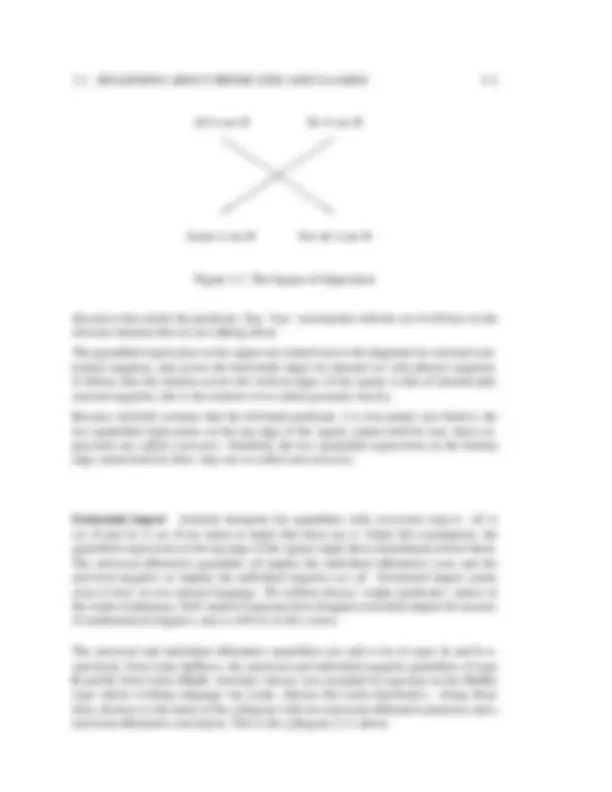
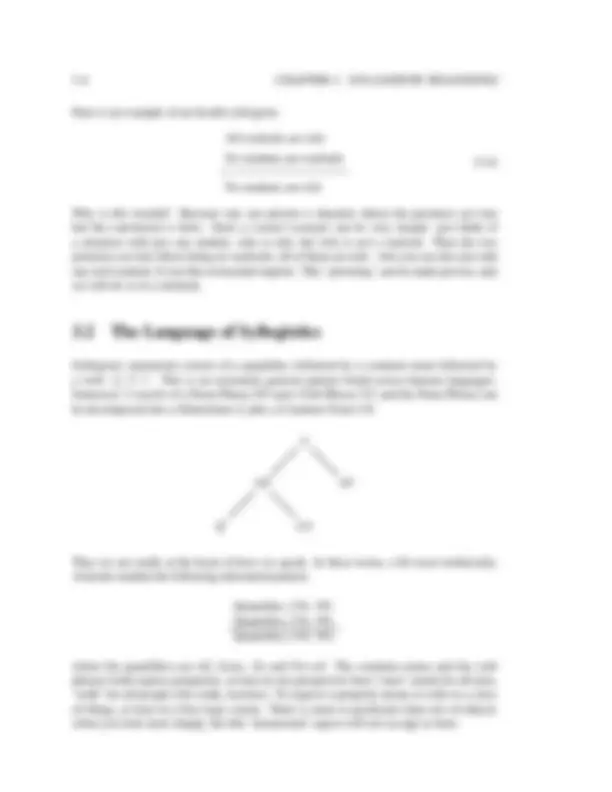
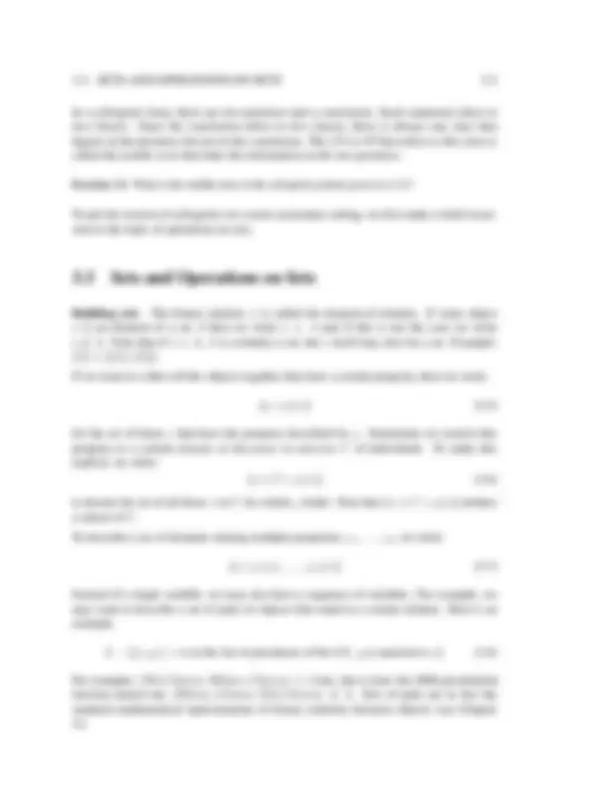
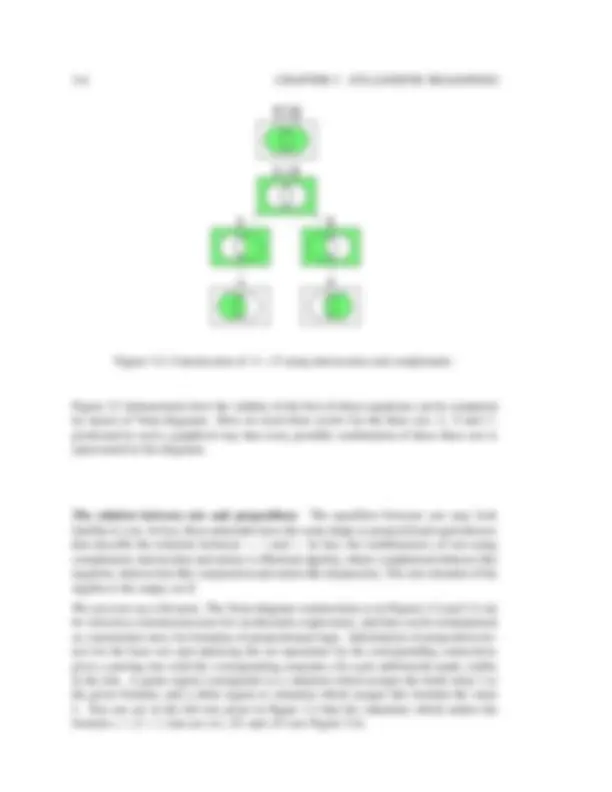
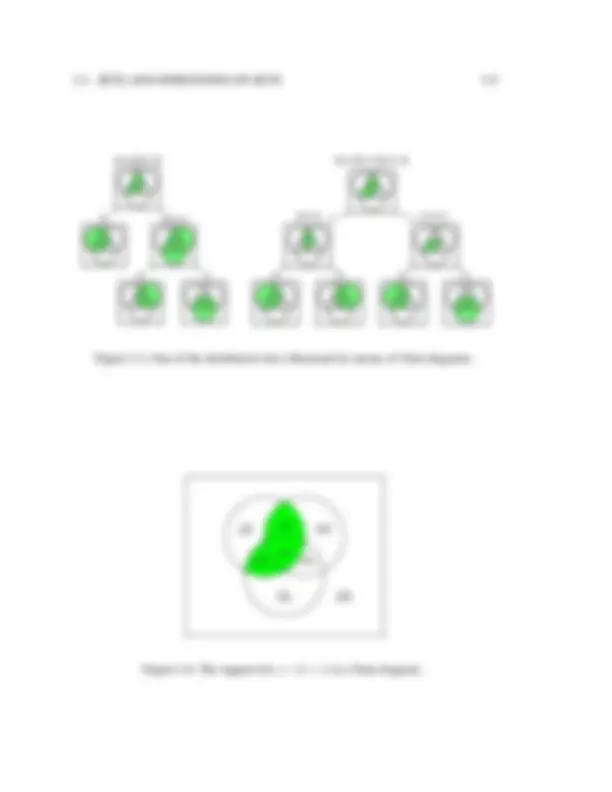
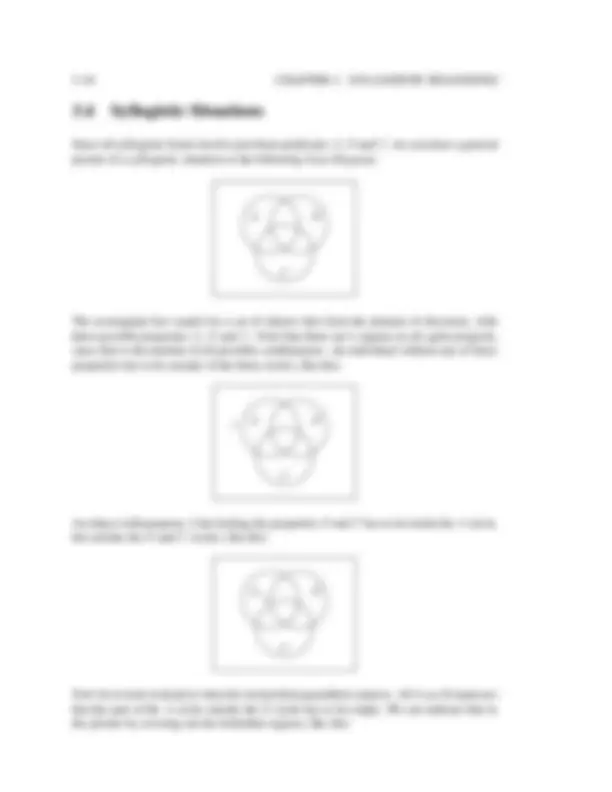
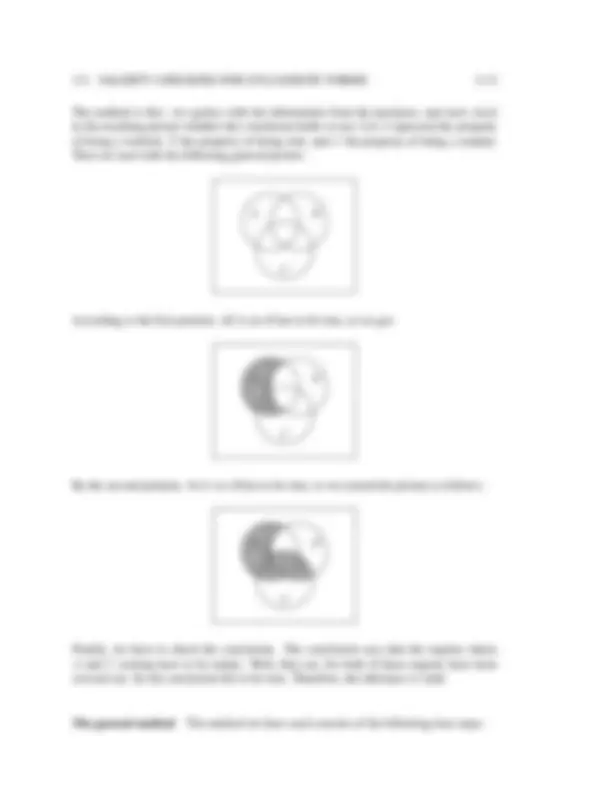
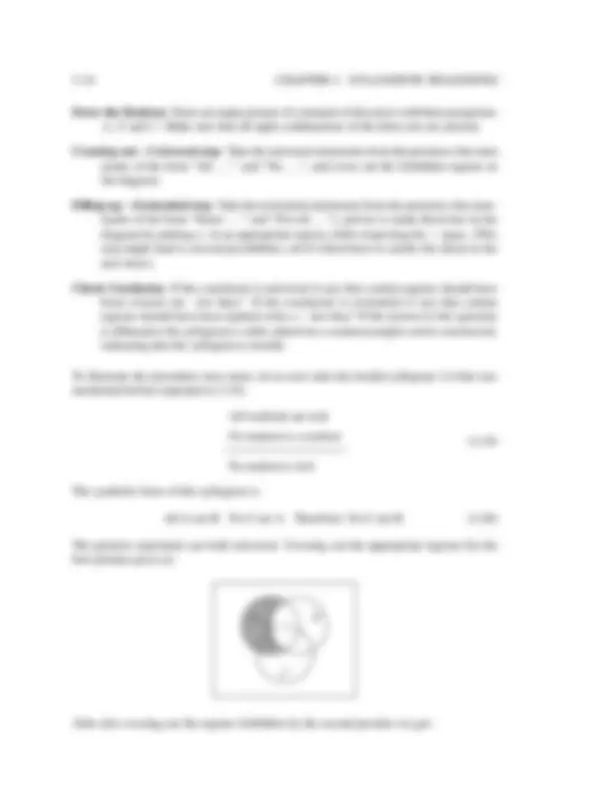
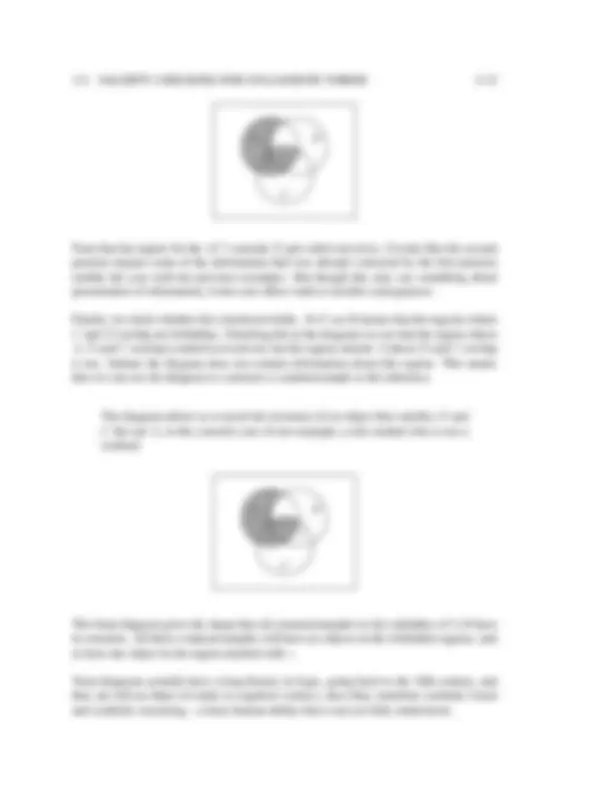
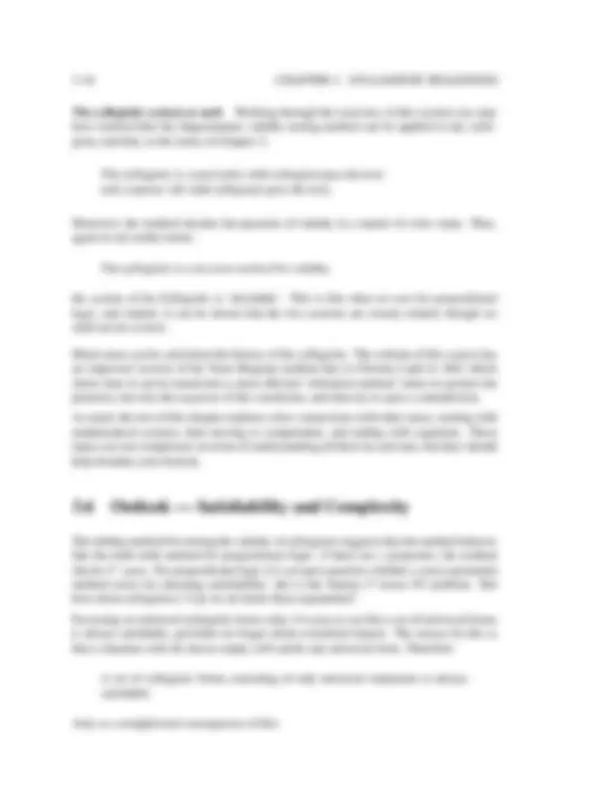
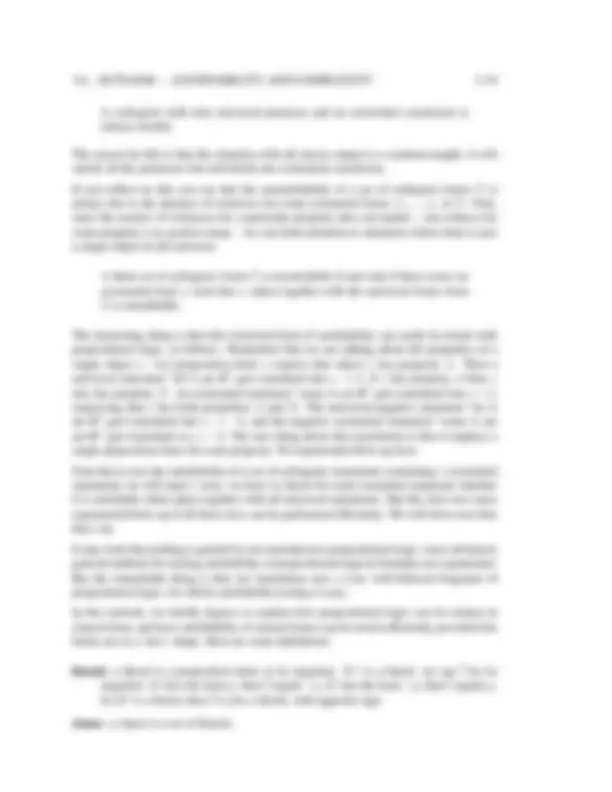
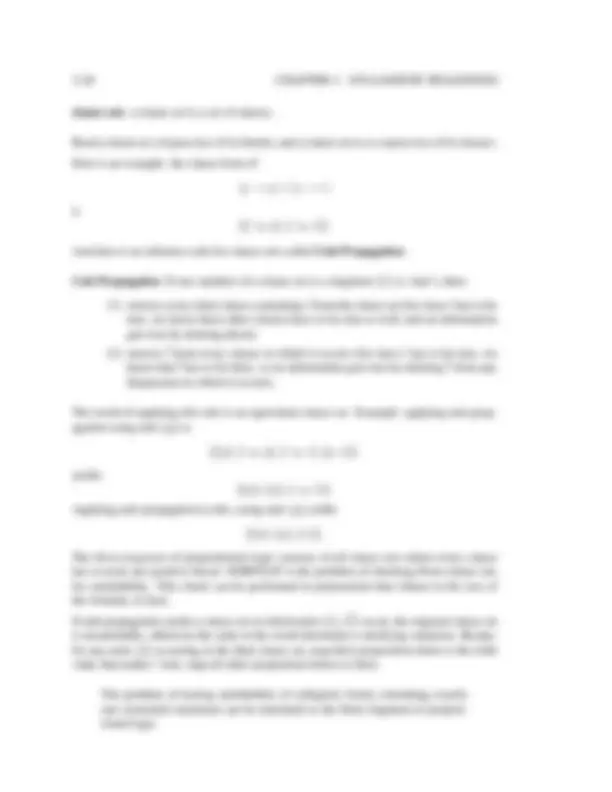
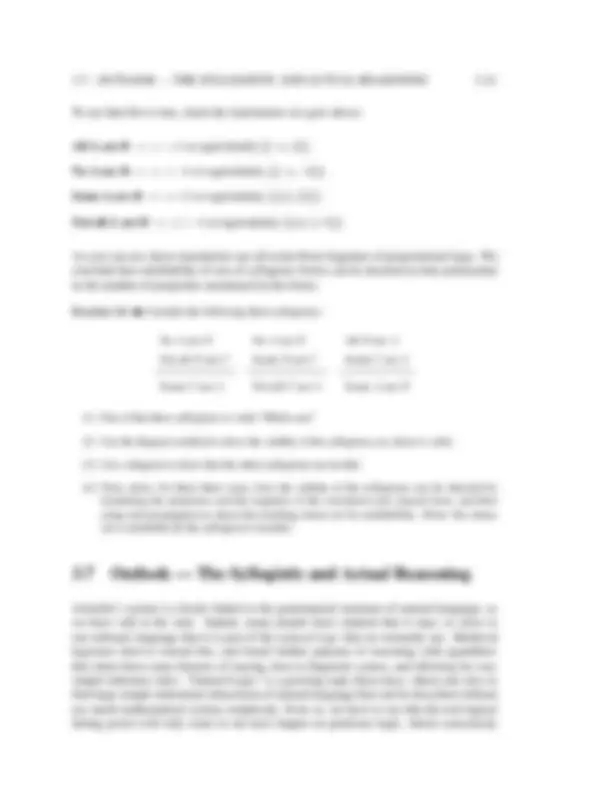
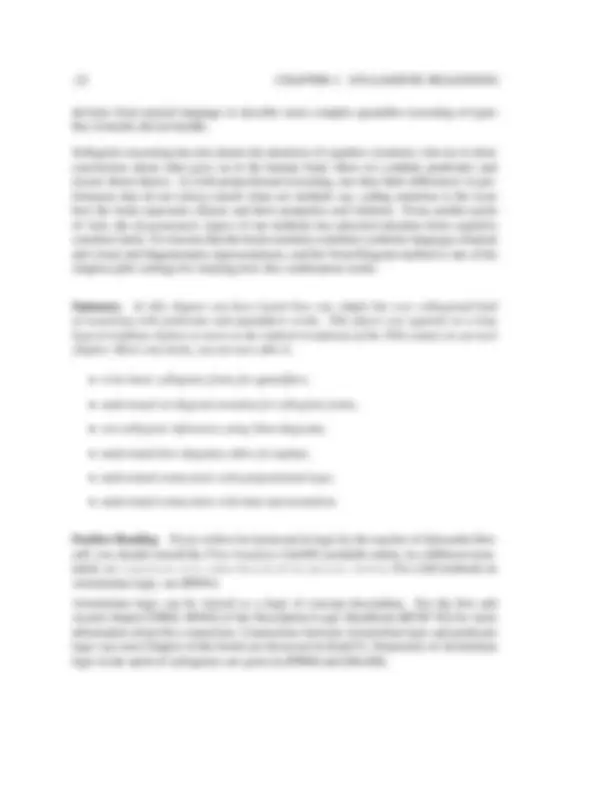


Study with the several resources on Docsity

Earn points by helping other students or get them with a premium plan


Prepare for your exams
Study with the several resources on Docsity

Earn points to download
Earn points by helping other students or get them with a premium plan
Community
Ask the community for help and clear up your study doubts
Discover the best universities in your country according to Docsity users
Free resources
Download our free guides on studying techniques, anxiety management strategies, and thesis advice from Docsity tutors
The concept of syllogistic reasoning through the lens of quantifiers, sets, and Venn diagrams. It covers the basics of syllogistic forms, set operations, and the use of Venn diagrams for testing syllogistic inferences. The document also highlights the connections between syllogistic reasoning and propositional logic, as well as data representation.
Typology: Study notes
1 / 22

This page cannot be seen from the preview
Don't miss anything!















This chapter ‘opens the box’ of propositional logic, and looks further inside the statements that we make when we describe the world. Very often, these statements are about objects and their properties, and we will now show you a first logical system that deals with these. Syllogistics has been a standard of logical reasoning since Greek Antiquity. It deals with quantifiers like ‘All P are Q’ and ‘Some P are Q’, and it can express much of the common sense reasoning that we do about predicates and their corresponding sets of objects. You will learn a famous graphical method for dealing with this, the so-called ‘Venn Diagrams’, after the British mathematician John Venn (1834–1923), that can tell valid syllogisms from invalid ones. As usual, the chapter ends with some outlook issues, toward logical systems of inference, and again some phenomena in the real world of linguistics and cognition.
Aristotle John Venn
The Greek philosopher Aristotle (384 BC – 322 BC) proposed a system of reasoning in his Prior Analytics (350 BC) that was so successful that it has remained a paradigm of
logical reasoning for more than two thousand years: the Syllogistic.
Syllogisms A syllogism is a logical argument where a quantified statement of a specific form (the conclusion) is inferred from two other quantified statements (the premises).
The quantified statements are all of the form “Some/all A are B,” or “Some/all A are not B,” and each syllogism combines three predicates or properties. Notice that “All A are not B” can be expressed equivalently in natural language as “No A are B,” and “Some A are not B” as “Not all A are B.” We can see these quantified statements as describing relations between predicates, which is well-suited to describing hierarchies of properties. Indeed, Aristotle was also an early biologist, and his classifications of predicates apply very well to reasoning about species of animals or plants.
Your already know the following notion. A syllogism is called valid if the conclusion follows logically from the premises in the sense of Chapter 2: whatever we take the real predicates and objects to be: if the premises are true, the conclusion must be true. The syllogism is invalid otherwise.
Here is an example of a valid syllogism:
All Greeks are humans All humans are mortal
All Greeks are mortal.
We can express the validity of this pattern using the |= sign introduced in Chapter 2:
All Greeks are humans, All humans are mortal |= All Greeks are mortal. (3.2)
This inference is valid, and, indeed, this validity has nothing to do with the particular predicates that are used. If the predicates human, Greek and mortal are replaced by dif- ferent predicates, the result will still be a valid syllogism. In other words, it is the form that makes a valid syllogism valid, not the content of the predicates that it uses. Replacing the predicates by symbols makes this clear:
All A are B All B are C
All A are C.
The classical quantifiers Syllogistic theory focusses on the quantifiers in the so called Square of Opposition, see Figure (3.1). The quantifiers in the square express relations between a first and a second predicate, forming the two arguments of the assertion. We think of these predicates very concretely, as sets of objects taken from some domain of
Here is an example of an invalid syllogism:
All warlords are rich No students are warlords
No students are rich
Why is this invalid? Because one can picture a situation where the premises are true but the conclusion is false. Such a counter-example can be very simple: just think of a situation with just one student, who is rich, but who is not a warlord. Then the two premises are true (there being no warlords, all of them are rich – but you can also just add one rich warlord, if you like existential import). This ‘picturing’ can be made precise, and we will do so in a moment.
Syllogistic statements consist of a quantifier, followed by a common noun followed by a verb: Q N V. This is an extremely general pattern found across human languages. Sentences S consist of a Noun Phrase NP and a Verb Phrase VP, and the Noun Phrase can be decomposed into a Determiner Q plus a Common Noun CN:
Thus we are really at the heart of how we speak. In these terms, a bit more technically, Aristotle studied the following inferential pattern:
Quantifier 1 CN 1 VP 1 Quantifier 2 CN 2 VP 2 Quantifier 3 CN 3 VP 3
where the quantifiers are All, Some, No and Not all. The common nouns and the verb phrases both express properties, at least in our perspective here (‘man’ stands for all men, ‘walk’ for all people who walk, etcetera). To express a property means to refer to a class of things, at least in a first logic course. There is more to predicates than sets of objects when you look more deeply, but this ‘intensional’ aspect will not occupy us here.
In a syllogistic form, there are two premises and a conclusion. Each statement refers to two classes. Since the conclusion refers to two classes, there is always one class that figures in the premises but not in the conclusion. The CN or VP that refers to this class is called the middle term that links the information in the two premises.
Exercise 3.1 What is the middle term in the syllogistic pattern given in (3.3)?
To put the system of syllogistics in a more systematic setting, we first make a brief excur- sion to the topic of operations on sets.
Building sets The binary relation ∈ is called the element-of relation. If some object a is an element of a set A then we write a ∈ A and if this is not the case we write a 6 ∈ A. Note that if a ∈ A, A is certainly a set, but a itself may also be a set. Example: { 1 } ∈ {{ 1 }, { 2 }}.
If we want to collect all the objects together that have a certain property, then we write:
{x | ϕ(x)} (3.5)
for the set of those x that have the property described by ϕ. Sometimes we restrict this property to a certain domain of discourse or universe U of individuals. To make this explicit, we write:
{x ∈ U | ϕ(x)} (3.6)
to denote the set of all those x in U for which ϕ holds. Note that {x ∈ U | ϕ(x)} defines a subset of U.
To describe a set of elements sharing multiple properties ϕ 1 ,... , ϕn we write:
{x | ϕ 1 (x),... , ϕn(x)} (3.7)
Instead of a single variable, we may also have a sequence of variables. For example, we may want to describe a set of pairs of objects that stand in a certain relation. Here is an example.
A = {(x, y) | x is in the list of presidents of the US , y is married to x} (3.8)
For example, (Bill Clinton, Hillary Clinton) ∈ A but, due to how the 2008 presidential election turned out, (Hillary Clinton, Bill Clinton) 6 ∈ A. Sets of pairs are in fact the standard mathematical representation of binary relations between objects (see Chapter A).
These pictorial representations of the set operations are called Venn diagrams, after the British mathematician John Venn (1834 - 1923). In a Venn diagram, sets are represented as circles placed in such a way that each combination of these sets is represented. In the case of two sets this is done by means of two partially overlapping circles. Venn diagrams are easy to understand, and interestingly, they are a method that also exploits our powers of non-linguistic visual reasoning.
Next, there is the complement of a set (relative to some given universe U (the domain of discourse): A = {x ∈ U | x 6 ∈ A} (3.12)
In a picture:
Making use of complements we can describe things that do not have a certain property.
The complement operation makes it possible to define set theoretic operations in terms of each other. For example, the difference of two sets A and B is equal to the intersection of A and the complement of B: A \ B = A ∩ B (3.13)
Complements of complements give the original set back:
A = A (3.14)
Complement also allows us to relate union to intersection, by means of the following so-called de Morgan equations:
A ∪ B = A ∩ B A ∩ B = A ∪ B
From the second de Morgan equation we can derive a definition of the union of two sets in terms of intersection and complement:
A ∪ B = A ∪ B = A ∩ B (3.16)
This construction is illustrated with Venn diagrams in Figure 3.2. Also important are the so-called distributive equations for set operations; they describe how intersection dis- tributes over union and vice versa:
A ∩ (B ∪ C) = (A ∩ B) ∪ (A ∩ C) A ∪ (B ∩ C) = (A ∪ B) ∩ (A ∪ C)
A B
A B
Figure 3.2: Construction of A ∪ B using intersection and complement.
Figure 3.3 demonstrates how the validity of the first of these equations can be computed by means of Venn-diagrams. Here we need three circles for the three sets A, B and C, positioned in such a graphical way that every possible combination of these three sets is represented in the diagrams.
The relation between sets and propositions The equalities between sets may look familiar to you. In fact, these principles have the same shape as propositional equivalences that describe the relations between ¬, ∧ and ∨. In fact, the combinatorics of sets using complement, intersection and union is a Boolean algebra, where complement behaves like negation, intersection like conjunction and union like disjunction. The zero element of the algebra is the empty set ∅.
We can even say a bit more. The Venn-diagram constructions as in Figures 3.2 and 3.3 can be viewed as construction trees for set-theoretic expressions, and they can be reinterpreted as construction trees for formulas of propositional logic. Substitution of proposition let- ters for the base sets and replacing the set operations by the corresponding connectives gives a parsing tree with the corresponding semantics for each subformula made visible in the tree. A green region corresponds to a valuation which assigns the truth-value 1 to the given formula, and a white region to valuation which assigns this formula the value
Since all syllogistic forms involve just three predicates A, B and C, we can draw a general picture of a syllogistic situation as the following Venn Diagram:
The rectangular box stands for a set of objects that form the domain of discourse, with three possible properties A, B and C. Note that there are 8 regions in all, quite properly, since that is the number of all possible combinations. An individual without any of these properties has to be outside of the three circles, like this:
An object with property A but lacking the properties B and C has to be inside the A circle, but outside the B and C circles, like this:
Now let us look in detail at what the Aristotelian quantifiers express. All A are B expresses that the part of the A circle outside the B circle has to be empty. We can indicate that in the picture by crossing out the forbidden regions, like this:
Note that the preceding picture does not take existential import into account. As we already said, we will leave it out in the interest of simplicity. And we lose nothing in this way. If you want to say that a predicate P is non-empty, you can always do so explicitly with a quantifier ‘Some’.
No A are B expresses that the part of the A circle that overlaps with the B circle has to be empty. Again, we can indicate this in a picture by crossing out the forbidden areas:
Again, existential import (“there must be A’s”) is not taken into account by this picture.
Now we move from universal quantifiers to existential ones. Some A are B expresses that the part of the picture where the A and the B circles overlap has to be non-empty. We can indicate that in the picture by putting an individual in an appropriate position. Since we do not know if that individual has property C or not, this can be done in two ways:
Not all A are B, or equivalently Some are are not B, expresses that the part of the A circle that falls outside the B circle has to be non-empty. There has to be at least one individual
The method is this: we update with the information from the premises, and next check in the resulting picture whether the conclusion holds or not. Let A represent the property of being a warlord, B the property of being rich, and C the property of being a student. Then we start with the following general picture:
According to the first premise, All A are B has to be true, so we get:
By the second premise, No C are B has to be true, so we extend the picture as follows:
Finally, we have to check the conclusion. The conclusion says that the regions where A and C overlap have to be empty. Well, they are, for both of these regions have been crossed out. So the conclusion has to be true. Therefore, the inference is valid.
The general method The method we have used consists of the following four steps:
Draw the Skeleton Draw an empty picture of a domain of discourse with three properties A, B and C. Make sure that all eight combinations of the three sets are present.
Crossing out – Universal step Take the universal statements from the premises (the state- ments of the form “All... ” and “No... ”, and cross out the forbidden regions in the diagram.
Filling up – Existential step Take the existential statements from the premises (the state- ments of the form “Some... ” and “Not all... ”), and try to make them true in the diagram by putting a ◦ in an appropriate region, while respecting the × signs. (This step might lead to several possibilities, all of which have to satisfy the check in the next item.)
Check Conclusion If the conclusion is universal it says that certain regions should have been crossed out. Are they? If the conclusion is existential it says that certain regions should have been marked with a ◦. Are they? If the answer to this question is affirmative the syllogism is valid; otherwise a counterexample can be constructed, indicating that the syllogism is invalid.
To illustrate the procedure once more, let us now take the invalid syllogism 3.4 that was mentioned before (repeated as 3.19).
All warlords are rich No student is a warlord
No student is rich
The symbolic form of this syllogism is:
All A are B No C are A Therefore: No C are B. (3.20)
The premise statements are both universal. Crossing out the appropriate regions for the first premise gives us:
After also crossing out the regions forbidden by the second premise we get:
Exercise 3.2 Check the following syllogistism for validity, using the method just explained.
Some philosophers are Greek No Greeks are barbarians
No philosophers are barbarians.
(3.21)
Exercise 3.3 Check the following syllogistic pattern for validity.
No Greeks are barbarians No barbarians are philosophers
No Greeks are philosophers.
(3.22)
Exercise 3.4 Check the following syllogistic pattern for validity.
No Greeks are barbarians Some barbarians are philosophers
Not all philosophers are Greek.
(3.23)
Exercise 3.5 Can you modify the method so that it checks for syllogistic validity, but now with the quantifiers all read with existential import? How?
More than three predicates What follows is a digression for the interested reader. Venn diagrams were a high point of traditional logic, just before modern logic started. How far does this method take us?
The validity check for syllogistics can be extended to inferences with more than two premises (and more than three predicates). This can still be done graphically (Venn had several beautiful visualizations), but you may also want to think a bit more prosaically in terms of tabulating possibilities. Here is one way (disregarding matters of computational efficiency).
For purposes of exposition, assume that four predicates A, B, C, D occur in the inference. List all possible combinations in a table (compare the tables for the propositonal variables in Chapter 2 – we economized a bit here, writing the property only when it holds):
Take as example the following entailment
All A are B, No C are B, Some C are D, Therefore: Not all D are A. (3.24)
Again we can use the update method to check whether this is valid. First update with the information that all A are B. This rules out certain possibilities:
All A are B
The information that no C are B also rules out possibilities, as follows:
A B AB C AC BC × ABC × D AD BD ABD CD ACD BCD × ABCD ×
No C are B
Combining these two updates, we get:
A × B AB C AC × BC × ABC × D AD × BD ABD CD ACD × BCD × ABCD ×
All A are B and No C are B
The third premise, “some C are D,” is existential. It states that there has to at least one CD combination in the table. There is only one possibility for this:
Finally, we must check whether “not all D are A” holds in the table that results from updating with the premises. And indeed it does: region CD is non-empty (indicated by the presence of the ◦), so it gives us a witness of a D which is not an A. Therefore, the given inference must be valid.
A syllogism with only universal premises and an existential conclusion is always invalid.
The reason for this is that the situation with all classes empty is a counterexample: it will satisfy all the premisses but will falsify the existential conclusion.
If you reflect on this you see that the unsatisfiability of a set of syllogistic forms Σ is always due to the absence of witnesses for some existential forms ψ 1 , ..., ψn in Σ. Now, since the number of witnesses for a particular property does not matter – one witness for some property is as good as many – we can limit attention to situations where there is just a single object in the universe:
A finite set of syllogistic forms Σ is unsatisfiable if and only if there exists an existential form ψ such that ψ taken together with the universal forms from Σ is unsatifiable.
The interesting thing is that this restricted form of satisfiability can easily be tested with propositional logic, as follows. Remember that we are talking about the properties of a single object x. Let proposition letter a express that object x has property A. Then a universal statement “all A are B” gets translated into a → b: if x has property A then x also has property B. An existential statement “some A are B” gets translated into a ∧ b, expressing that x has both properties A and B. The universal negative statement “no A are B” gets translated into a → ¬b, and the negative existential statement “some A are not B” gets translated as a ∧ ¬b. The nice thing about this translation is that it employs a single proposition letter for each property. No exponential blow-up here.
Note that to test the satisfiability of a set of syllogistic statements containing n existential statements we will need n tests: we have to check for each existential statement whether it is satisfiable when taken together with all universal statements. But this does not cause exponential blow-up if all these tests can be performed efficiently. We will show now that they can.
It may look like nothing is gained by our translation to propositional logic, since all known general methods for testing satisfiability of propositional logical formulas are exponential. But the remarkable thing is that our translation uses a very well-behaved fragment of propositional logic, for which satisfiability testing is easy.
In this outlook, we briefly digress to explain how propositional logic can be written in clausal form, and how satisfiability of clausal forms can be tested efficiently, provided the forms are in a ‘nice’ shape. Here are some definitions:
literals a literal is a proposition letter or its negation. If l is a literal, we use l for its negation: if l has the form p, then l equals ¬p, if l has the form ¬p, then l equals p. So if l is a literal, then l is also a literal, with opposite sign.
clause a clause is a set of literals.
clause sets a clause set is a set of clauses.
Read a clause as a disjunction of its literals, and a clause set as a conjunction of its clauses.
Here is an example: the clause form of
(p → q) ∧ (q → r)
is {{¬p, q}, {¬q, r}}.
And here is an inference rule for clause sets called Unit Propagation:
Unit Propagation If one member of a clause set is a singleton {l} (a ‘unit’), then:
(1) remove every other clause containing l from the clause set (for since l has to be true, we know these other clauses have to be true as well, and no information gets lost by deleting them); (2) remove l from every clause in which it occurs (for since l has to be true, we know that l has to be false, so no information gets lost by deleting l from any disjunction in which it occurs).
The result of applying this rule is an equivalent clause set. Example: applying unit prop- agation using unit {p} to
{{p}, {¬p, q}, {¬q, r}, {p, s}}.
yields: {{p}, {q}, {¬q, r}}.
Applying unit propagation to this, using unit {q} yields
{{p}, {q}, {r}}.
The Horn fragment of propositional logic consists of all clause sets where every clause has at most one positive literal. HORNSAT is the problem of checking Horn clause sets for satisfiability. This check can be performed in polynomial time (linear in the size of the formula, in fact).
If unit propagation yields a clause set in which units {l}, {l} occur, the original clause set is unsatisfiable, otherwise the units in the result determine a satisfying valuation. Recipe: for any units {l} occurring in the final clause set, map their proposition letter to the truth value that makes l true; map all other proposition letters to false.
The problem of testing satisfiability of syllogistic forms containing exactly one existential statement can be translated to the Horn fragment of proposi- tional logic.